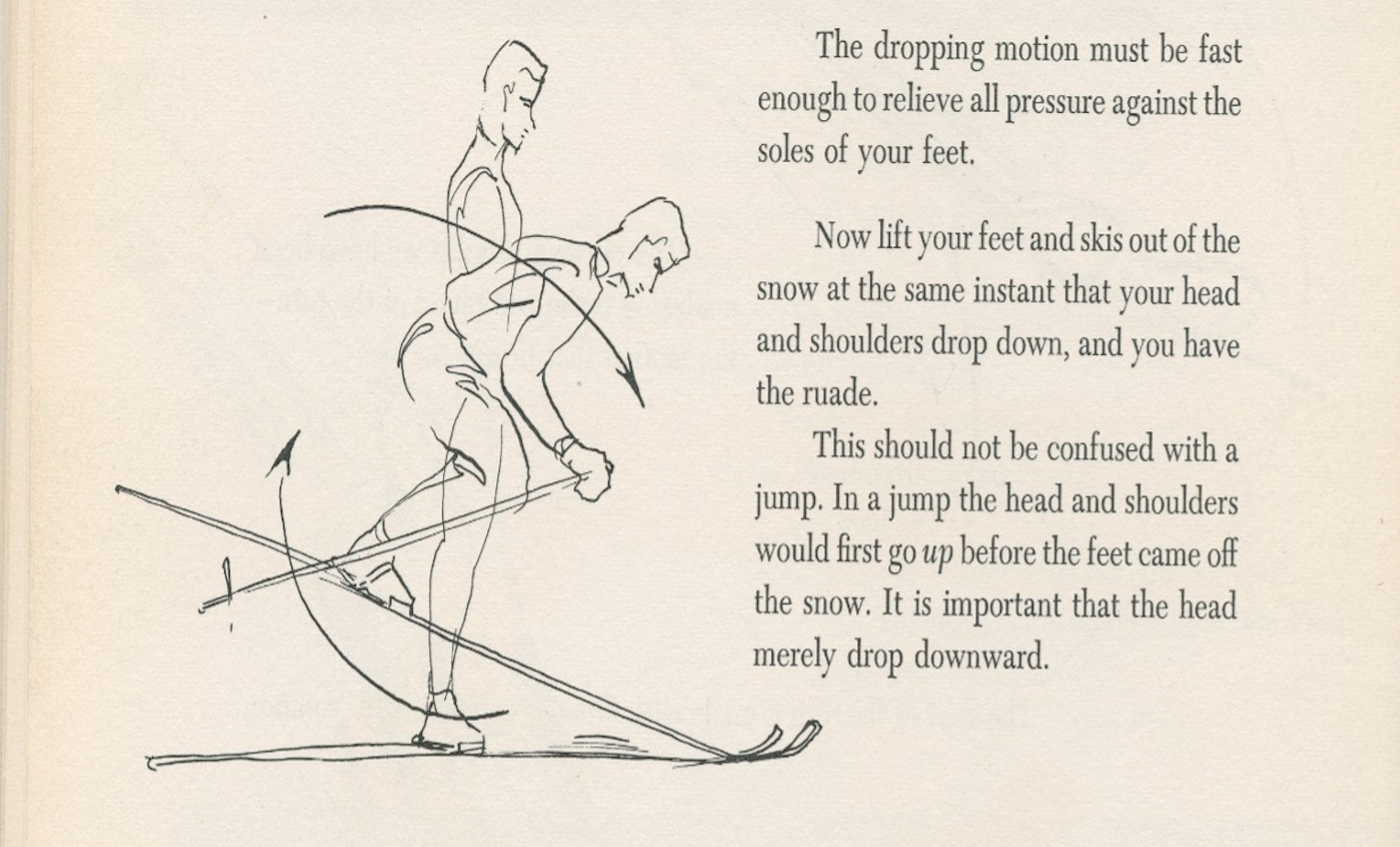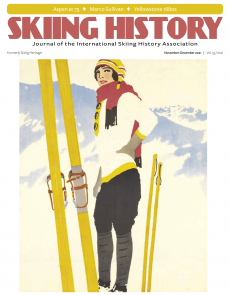SKIING HISTORY
Editor Seth Masia
Managing Editor Greg Ditrinco
Consulting Editor Cindy Hirschfeld
Art Director Edna Baker
Editorial Board
Seth Masia, Chairman
John Allen, Andy Bigford, John Caldwell, Jeremy Davis, Kirby Gilbert, Paul Hooge, Jeff Leich, Ron LeMaster, Bob Soden, Ingrid Wicken
Founding Editors
Morten Lund, Glenn Parkinson
To preserve skiing history and to increase awareness of the sport’s heritage
ISHA Founder
Mason Beekley, 1927–2001
ISHA Board of Directors
Rick Moulton, Chairman
Seth Masia, President
Wini Jones, Vice President
Jeff Blumenfeld, Vice President
John McMurtry, Vice President
Bob Soden (Canada), Treasurer
Einar Sunde, Secretary
Richard Allen, Skip Beitzel, Michael Calderone, Dick Cutler, Ken Hugessen (Canada), David Ingemie, Joe Jay Jalbert, Henri Rivers, Charles Sanders, Christof Thöny (Austria), Ivan Wagner (Switzerland)
Presidential Circle
Christin Cooper, Billy Kidd, Jean-Claude Killy, Bode Miller, Doug Pfeiffer, Penny Pitou, Nancy Greene Raine
Executive Director
Janet White
janet@skiinghistory.org
Membership Services
Laurie Glover
(802) 375-1105
laurie@skiinghistory.org
Corporate Sponsorships
Peter Kirkpatrick
(541) 944-3095
peterk10950@gmail.com
Bimonthly journal and official publication of the International Skiing History Association (ISHA)
Partners: U.S. Ski and Snowboard Hall of Fame | Canadian Ski Museum and Hall of Fame
Alf Engen Ski Museum | North American Snowsports Journalists Association | Swiss Academic Ski Club
Skiing History (USPS No. 16-201, ISSN: 23293659) is published bimonthly by the International Skiing History Association, P.O. Box 1064, Manchester Center, VT 05255.
Periodicals postage paid at Manchester Center, VT and at additional mailing offices. Postmaster: Send address changes to ISHA, P.O. Box 1064, Manchester Center, VT 05255
ISHA is a 501(c)(3) public charity. EIN: 06-1347398
Written permission from the editor is required to reproduce, in any manner, the contents of Skiing History, either in full or in part.
Ski Technique: Whatever Happened to Ruade?
The "horse-kick" turn, introduced by Emile Allais, evolved into down-unweighting.
In the library of ski techniques, ruade is a rarity. At one time it had significant currency in some upper echelons of skiing but is now virtually extinct.
Illustration above: Édouard Frendo’s book introduced ruade—and down-unweighting—to the world.
It was developed in France in the 1940s, and championed by Emile Allais, for the purpose of making short-radius parallel turns. The French wanted skiers to get beyond the stem christiania as soon as possible, and felt that up-unweighting and shoulder rotation imposed too ponderous a tempo to work for short-radius, parallel turns, especially at lower speeds, on steeper slopes and in difficult snow.
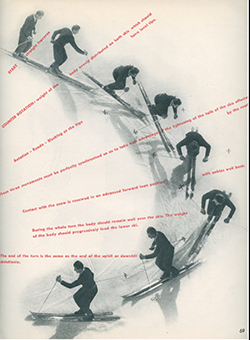
through active retraction.
What was needed at turn initiation was a way for a skier to unweight and rotate the skis in a single motion, then get the weight back down on the skis instantly. How do you do that on stiff, seven-foot wooden skis while wearing low, soft boots and using imprecise cable bindings?
The French solution was the ruade—literally a “horse-kick.” The idea was, starting from a tall stance, to pull the feet up and rock forward, thereby lifting the tails while keeping the tips planted on the snow. This was the
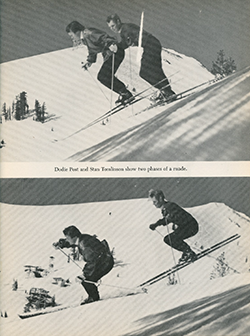
Stan Tomlinson demonstrate ruade.
introduction of what would later be called down-unweighting. Start to finish, ruade was much quicker than up-unweighting, and it put the skier back on the snow in a lower, more athletic posture to control the rest of the turn. Keeping the tips on the snow provided a pivot point, making it easy to swing the tails sideways while they were unweighted. In loose snow this technique had the added benefit of getting the skis out of the snow during the edge change, thereby avoiding catching an outside edge.
In 1946, Édouard Frendo, then director of Chamonix’s École Supérieure de Ski et d´Alpinisme, provided a detailed exposition of ruade in his book Le ski par la technique française. He described the novel down-unweighting move this way: “The kick is executed only by a sudden bending of the legs under the thighs, by strong bending of the knees and maximum ankle flexion, without a jump. It therefore represents a considerable time saving and allows faster, shorter turns.”
It’s important to note the emphasis on the skier actively pulling the feet up. This isn’t passively down-unweighting by relaxing muscles in the legs, hips and back and letting your body fall. It’s actively down-unweighting by contracting muscles to make your body fold. This novelty would show up later, in a highly evolved form, in Jean-Claude Killy’s skiing. George Joubert called it avalement.
Allais followed in 1947 with his own book, which appeared in the U.S. under the title How to Ski by the French Method—Emile Allais’ Technic [sic]. This book was refreshingly light on text and laden with visuals, providing page upon page of graphically annotated photos and photo sequences.
Ruade comes to California
When Allais came to America in the late 1940s, he brought ruade with him. He had particular influence in California, especially at Squaw Valley, where he founded the ski school. Tyler Micoleau, a denizen of the early Tahoe ski area, wrote two books in the early 1950s, The Squaw Valley Story and Power Skiing Illustrated, in which he described Allais’ influence in general and the use of ruade in particular. California, a melting pot of different approaches to skiing, embraced ruade. Hans Georg, a Swiss veteran of the 10th Mountain Division who settled in Mammoth, gave it special mention in his 1954 book, Modern Ski Systems, and wrote a feature on the technique for the January 1956 issue of SKI.
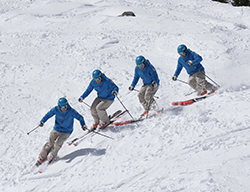
the active retraction and forward move-
ment of ruade in steep, wet spring snow.
Ron LeMaster photo.
It’s possible that this American infatuation with ruade was a misinterpretation of Allais’ message, focusing on the exotic and radical and interpreting it as essential and fundamental. It’s also possible that French nationalism motivated the École du ski français (ESF) program to highlight a technique that no one else had ever imagined. In a personal communication, Maurice Woerhlé recalls being told by Georges Joubert that, on returning from the U.S., Allais washorrified to learn that la ruade had become the final stage of the ESF program. Allais had regarded it mostly as a training tool. Bill Lash, who with Junior Bounous got to spend some time with Allais at Squaw Valley, similarly reports that Allais treated it as an exercise.
Ultimately, ruade in its mid-20th century form faded from sight. Woehrlé described it as “quasi-impossible to learn.” Better equipment reduced the need for such dramatic movements for making short turns, and the technique never osmosed very far beyond the Sierra Nevada
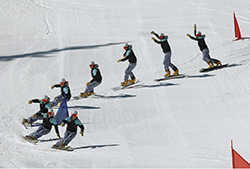
uses ruade to start an efficient carved
turn. Ron LeMaster photo.
mountains in the U.S. The French, too, lost interest.
The technique’s fundamental components, however, didn’t disappear from skiing or, for that matter, from snowboarding. Active down-unweighting, which to my knowledge was first described in Frendo’s book, has been alive and well ever since. And the mechanism of making the skis turn by keeping the tips pressed to the snow while unweighting the rest of the ski is used all the time, even though it’s not a named technique in any system I know of. 
The author would like to thank Maurice Woehrlé and Bill Lash for their help in developing this article.
Table of Contents
WORLD CHAMPIONSHIP ($3,000+)
BerkshireEast/Catamount Mountain Resorts
Gorsuch
Warren and Laurie Miller
Sport Obermeyer
Polartec
CHAMPIONSHIP ($2,000)
Fairbank Group Resorts
Hickory & Tweed
Rossignol
Snowsports Merchandising Corporation
WORLD CUP ($1,000)
Aspen Skiing Company
Bogner of America
Boyne Mountain Resort
Dale of Norway
Darn Tough Vermont
Dynastar/Lange/Look
Gordini USA Inc/Kombi LTD
Head Wintersports
Intuition Sports
Mammoth Mountain
Marker/Völkl USA
National Ski Areas Association
Outdoor Retailer
Ski Area Management
Ski Country Sports
Sports Specialists LTD
Sun Valley Resort
Vintage Ski World
World Cup Supply
GOLD MEDAL ($700)
Larson's Ski & Sports
Race Place/Beast Tuning Tools
The Ski Company (Vicki and Gary Profetta)
Thule
SILVER MEDAL ($500)
Alta Ski Area
Boden Architecture PLLC
Dalbello Sports
Deer Valley
EcoSign Mountain Resort Planners
Elan
Fera International
Holiday Valley Resort
Hotronic USA
Masterfit Enterprises
McWhorter Driscoll LLC
Metropolitan New York Ski Council
Mt. Bachelor
New Jersey Ski & Snowboard Council
Russell Mace Vacation Homes
SchoellerTextil
Scott Sports
Seirus Innovations
SeniorsSkiing.com
Ski Utah
Steamboat Ski & Resort Corp
Sundance Mountain Resort
Swiss Academic Ski Club
Tecnica Group USA
Timberline Lodge and Ski Area
Trapp Family Lodge
Western Winter Sports Reps Association
World Pro Ski Tour
Yellowstone Club

